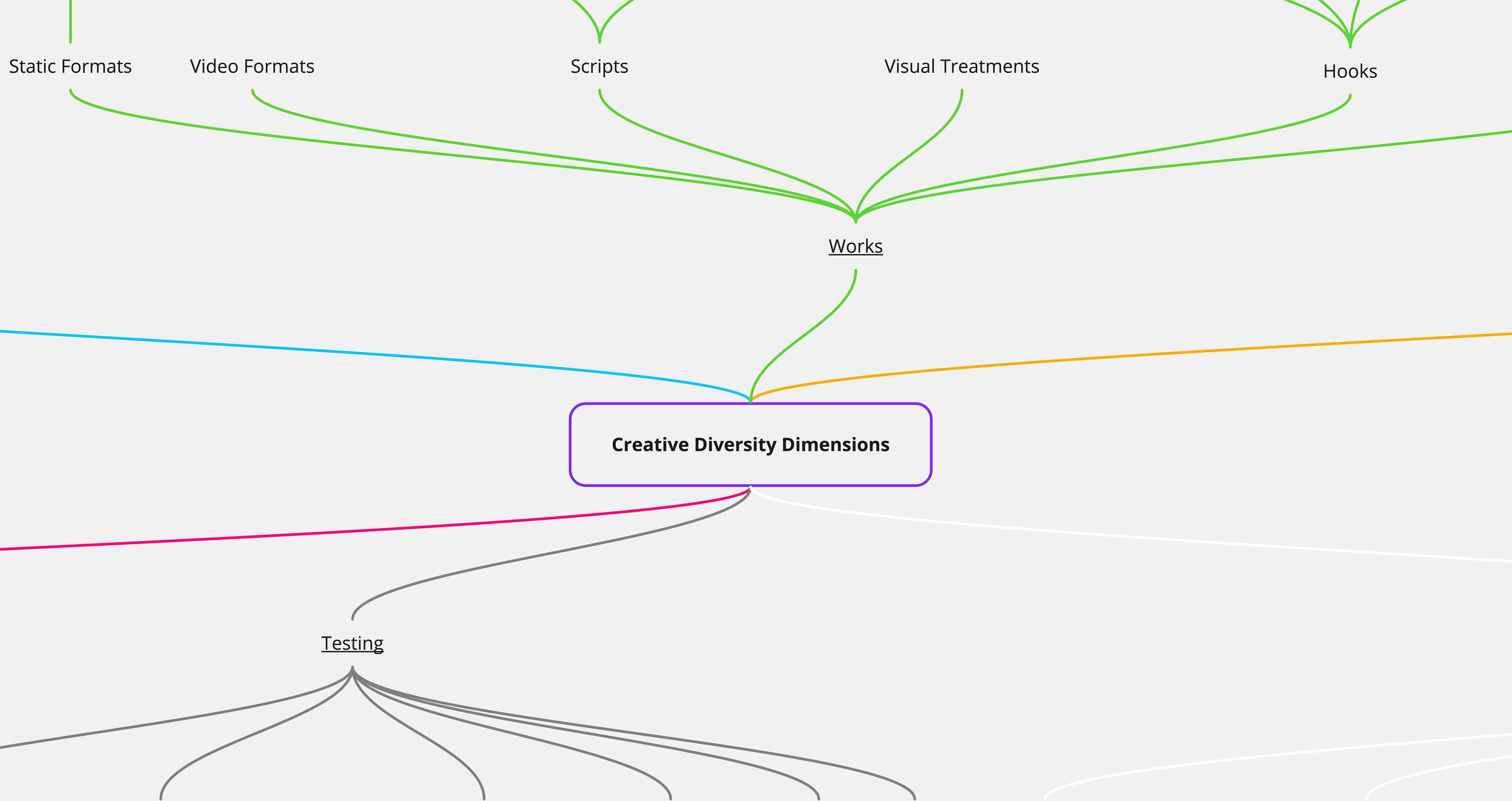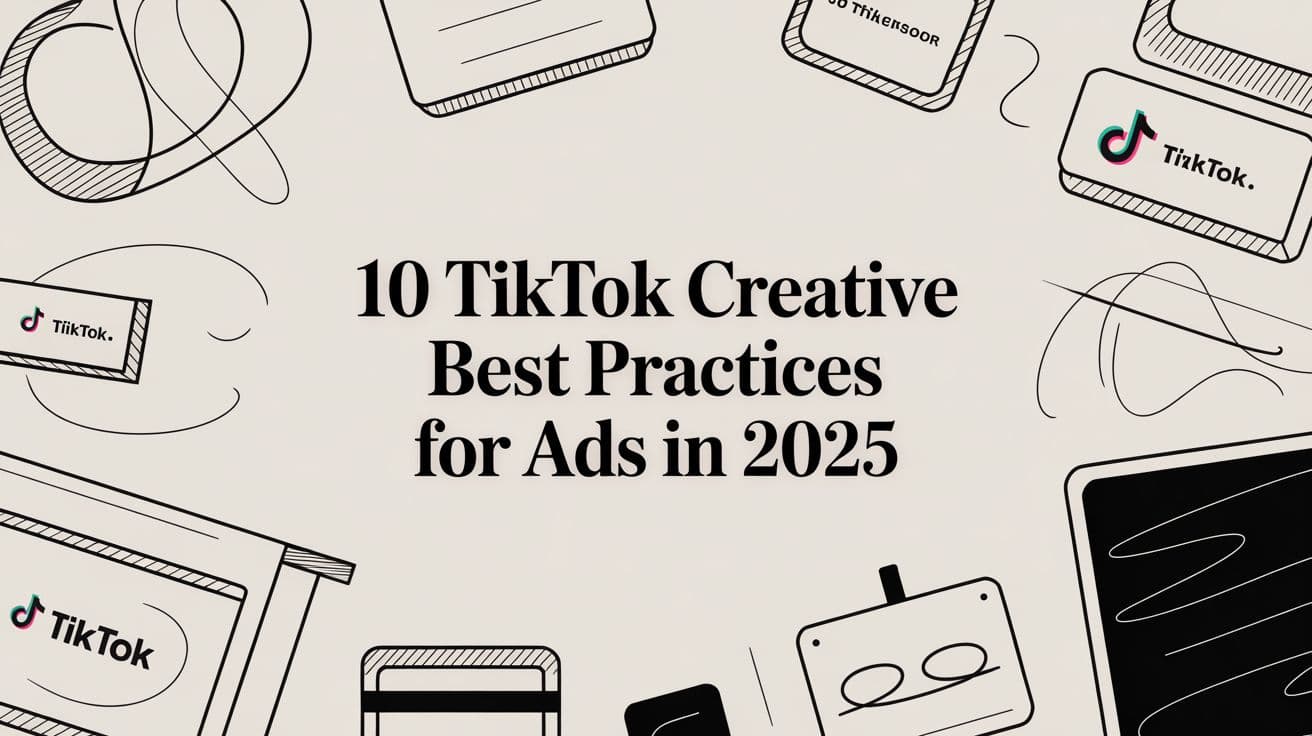Ultimate Guide to Mind Maps for Creative Strategy

It can feel pretty overwhelming when you’re dealing with a creative strategy that has so many moving parts. There are endless variations—different messaging angles, visual formats, audio treatments, and more. It’s easy to lose track of what’s working and what isn’t.
That’s where mind maps come in. If you're a visual learner, mind maps can help organize all those creative elements in one place. By breaking everything down, you can get a clear picture of which parts of your strategy are winning and which ones need more work.
In this post, I’m going to share how using mind maps can simplify your creative strategy, help you track what works, and even give you a better chance of success with your ad campaigns. Let’s get started!
Why Mind Maps are a Game Changer for Creative Strategy
Visualizing Multiple Creative Dimensions
One of the biggest challenges in creative strategy is handling all the different elements that come into play. You’ve got messaging angles, visual formats, scripts, hooks, and audio options. When you’re testing different combinations, it can quickly get messy. But when you lay it all out visually, using a mind map, things start to click.
Mind maps make it easier to see the connections between different elements. You can spot patterns, like which types of scripts work best with certain visual treatments or how specific hooks are impacting performance. This lets you quickly identify what’s working for your brand (or your client’s brand) and what needs tweaking.
Combining Winning Elements for Higher Success Rates
The great thing about mind maps is that they don’t just help you organize ideas—they help you create a strategy that’s backed by data. When you visualize all the elements that have worked in the past, you can combine them to build stronger campaigns.
For example, if you know a specific hook and a certain video format have performed well in separate tests, you can combine them to increase the chances of success. It’s not about guessing; it’s about using what you’ve already learned to improve your creative win rate over time.
Breaking Down Creative Dimensions in Mind Maps
When you start using mind maps for creative strategy, it's helpful to categorize each element based on its performance. This way, you know exactly where each piece of your strategy stands. Here’s how you can break it down:
Top Tier: Scalars
At the top, you’ve got elements I call "scalars." These are the creative pieces that consistently perform well. Whether it’s a specific video format, a hook, or a script, these elements have proven they can scale up your campaigns reliably. You can trust that these will keep working for you.
Middle of the Road Elements
Next, you’ve got the middle of the road. These are elements that sometimes hit the mark but aren’t consistent enough to rely on fully. For example, maybe a visual treatment or audio choice worked well in one campaign but fell flat in another. It’s good to know where these elements stand so you can experiment further, but don’t count on them to scale just yet.
Elements That Don’t Work
Then, there’s the stuff that just doesn’t work. Maybe it’s a static image format you’ve tried repeatedly, or a script style that never quite hits the target. It’s important to keep track of these so you can avoid wasting time and resources on things that aren’t moving the needle.
Ideas Bucket and Current Testing
Finally, we’ve got the "ideas bucket" and "current testing" sections. This is where all the creative ideas go before you’ve tested them. These could be new messaging angles, visual treatments, or hooks you want to try out. By having a clear spot for untested ideas, you make it easier to visualize what’s next in your strategy and track how new concepts perform over time.
The Power of Creative Diversity in Video Ads
When it comes to video ads, diversity is key. You can’t just rely on one format or one style. Instead, test as many formats as possible to find out what works best for your audience. Here’s a look at some examples:
Testing Various Video and Static Formats
Different formats work for different audiences, so it’s always good to have a variety of options to test. For video, you can try formats like “before and after,” “us vs. them,” or even founder stories. Right now, AI-generated user-generated content (UGC) is a hot trend. People are testing it, and it seems to be doing just as well as regular UGC in many cases.
On the static side, there are endless options too. You can go for simple tweet-style posts, iMessage conversations, or even Apple Notes-style designs. Testing a range of formats gives you a better idea of what’s resonating with your audience.
Different Script Frameworks for Ads
Scripts are another area where diversity pays off. You don’t want to use the same formula over and over again. Instead, try out different script frameworks like "problem-agitate-solution," "feature-advantage-benefit," or even listicle-style ads.
Each script framework has its strengths. For example, the "problem-agitate-solution" script works great when you need to hook people by focusing on their pain points. Meanwhile, the "feature-advantage-benefit" script lets you focus on the benefits of your product. The key is to test and see which scripts work best for your specific product or audience.
Visual Treatments and Hooks for Improved Engagement
Unique Visual Treatments That Grab Attention
Visual treatments are all about how your ad looks and feels. Sometimes, just tweaking the visual style can make a big difference. For example, you’ve probably seen a split-screen video where one half shows someone playing a video game while the other half is a podcast clip. That’s a visual treatment, and it’s been a hit on platforms like TikTok.
Other times, it’s small details that can stand out, like adding a wrinkled effect to a post-it note design or applying a kaleidoscope effect to a video. These treatments catch people’s attention and make them pause, which is what you want in an ad.
Effective Hooks: Text, Audio, and Visual
Hooks are crucial for pulling people into your ad. There are three main types: text hooks, audio hooks, and visual hooks.
- Text Hooks: These are the lines that grab attention right away. For example, something like "Ever dreamed of playing your favorite songs?" could be a great way to draw in musicians or aspiring guitarists.
- Audio Hooks: Trending music or sounds that have gone viral can help your ad get noticed. People are more likely to engage with content that uses familiar or popular audio clips.
- Visual Hooks: This could be anything from an eye-catching animation to a well-timed visual effect. Visual hooks are often paired with text or audio to strengthen the overall impact.
The goal with hooks is to stop the scroll and make people pay attention to what you have to say. By testing different types of hooks, you’ll find what works best for your audience.
Conclusion
Mind maps are a simple but powerful tool to help you keep track of all the moving parts in your creative strategy. They make it easier to visualize what’s working, what isn’t, and what needs more testing. By organizing everything from script frameworks to visual treatments in a mind map, you can start building stronger, more reliable ad campaigns.
If you’re looking to get better results with your creative strategy, mind maps are definitely worth a try. They give you the confidence to combine elements that have already proven successful, boosting your creative win rate over time.
So, take the time to build your own creative mind map. It could be the game-changer you need to take your strategy to the next level.

Manson Chen
Founder, Sovran
Related Articles

3 Mental Models to Guide Your Creative Strategy
Creative strategy in advertising can feel like a puzzle. You know it’s crucial to test and refine, but figuring out what really works isn’t always...

10 TikTok Creative Best Practices for Ads in 2025
TikTok isn't just a platform for viral dances; it's a powerful performance marketing channel where creative is the ultimate variable for success. For growth...

Ultimate Guide to Creative Diversity for Facebook Ads
Everyone's talking about creative diversity in advertising, right? You hear about it all the time—how you need different visual concepts for your static and...